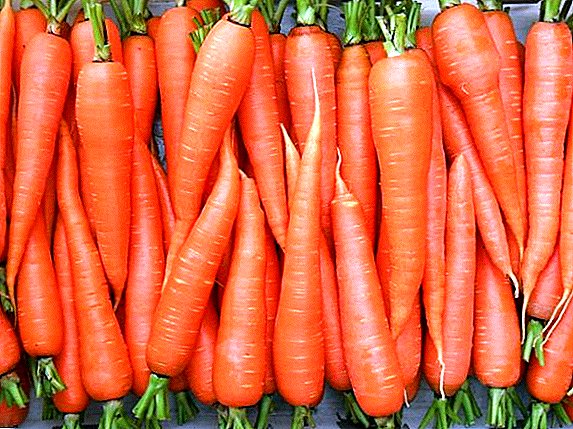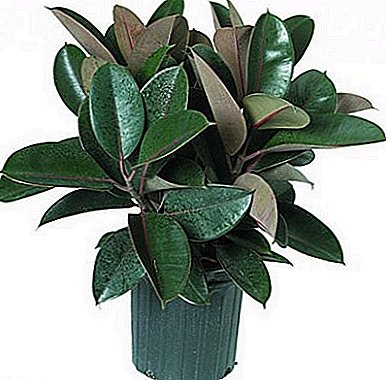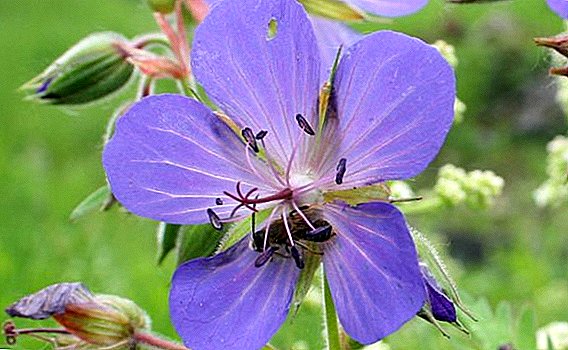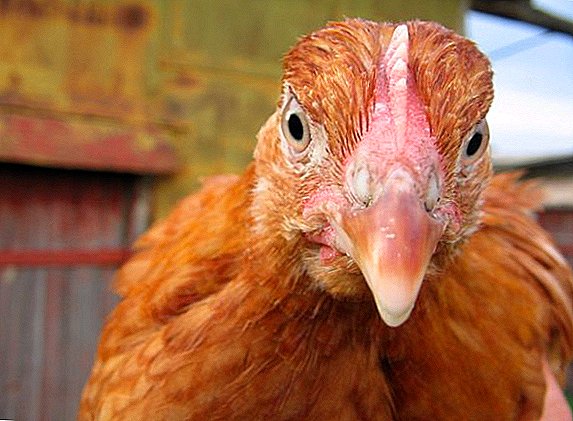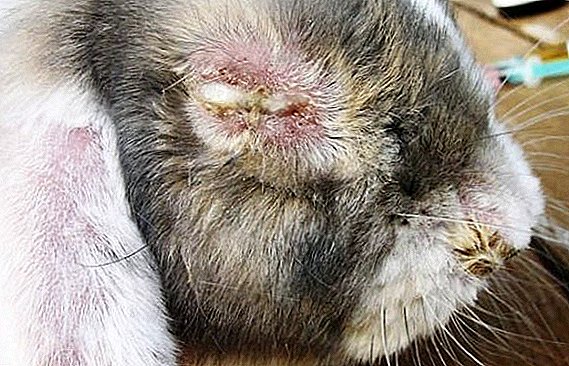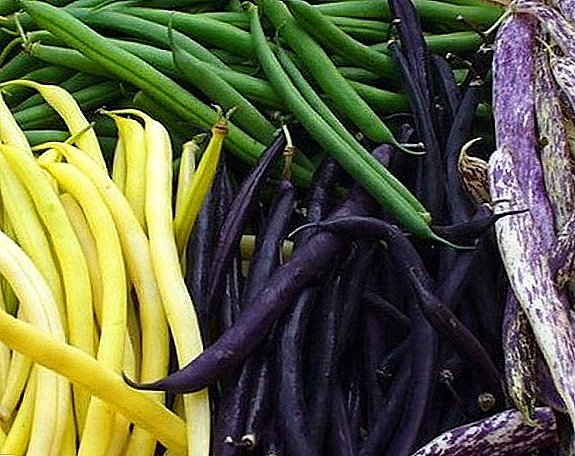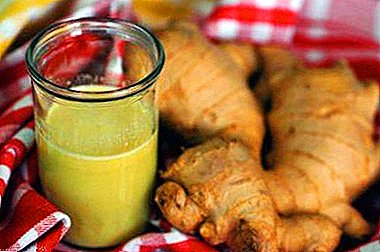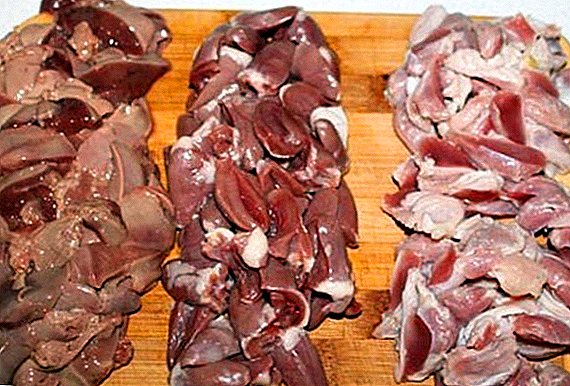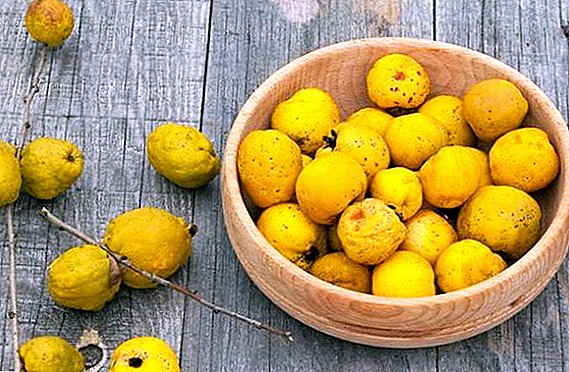 Not many people know about the beneficial properties of the Japanese quince (henomeles). This unpretentious, elegant flowering shrub and in modern times is a great surprise even among experienced gardeners, since most of the plant is associated with decorative intake shrubs. And this is not by chance.
Not many people know about the beneficial properties of the Japanese quince (henomeles). This unpretentious, elegant flowering shrub and in modern times is a great surprise even among experienced gardeners, since most of the plant is associated with decorative intake shrubs. And this is not by chance.
The view looks great as a protective barrier along a narrow country path. And especially colorful bushes quince look during flowering. Bright red and pink flowers of the plant are perfectly combined in the garden with the majority of ornamental species.
The main value of the shrub is its dense round fruits, which are abundantly covered with shoots. In addition to important vitamins, they are rich in a whole complex of useful substances that are able to please not only with unusual taste characteristics, but also a powerful beneficial effect for the overall health of the body.
And today we have to more deeply discover the Japanese quince, as well as all sorts of useful properties and contraindications to its use for medical purposes.
Short description
Shrub refers to the dicotyledonous flowering plants. The natural habitat of the species is Japan, and the plant is also widely distributed throughout Europe and China.  Regarding the botanical systematics, the species belongs to the genus Henomeles of the Rosaceae family. That is why the Japanese quince is so similar in its external description with many decorative and household flowers, popular in the garden.
Regarding the botanical systematics, the species belongs to the genus Henomeles of the Rosaceae family. That is why the Japanese quince is so similar in its external description with many decorative and household flowers, popular in the garden.
You can create a beautiful design of your garden with the help of such ornamental shrubs as: hydrangea, chubushnik, myricaria, honeysuckle, cotoneaster, deutsia, astilba, deren.
Chaenomeles belongs to deciduous low shrubs, the maximum height of which does not exceed 3 m. Young shoots have a bright color, which over time changes to brownish-black. The scaly-felt structure of the outer integument of mature branches changes to a smooth and naked one.
The leaves are small, obovate or spatulate in shape, tapered towards the base, with a serrated edge. Their length on average does not exceed 5 cm, and the width is 3 cm.
In the period of flowering shrub covered with small flowers. Their size in diameter does not exceed 4 cm, and shades are dominated by bright pink or red-orange shades. Sepals and petals are egg-shaped.  After flowering on the bush appear apple-like green fruits, almost spherical in shape, which after full maturation become a delicate yellow hue. The flesh of the fruit is edible, but it is very tough and dense with abundant patches of small brown seeds.
After flowering on the bush appear apple-like green fruits, almost spherical in shape, which after full maturation become a delicate yellow hue. The flesh of the fruit is edible, but it is very tough and dense with abundant patches of small brown seeds.
The chemical composition of the fruit
The fruits of chaenomeles are rich in many beneficial substances and compounds. In ripe fruit is about 12-13% percent of sugars. Among them, fructose, glucose and sucrose predominate, which are in the following ratio 3: 2: 1.
In addition to sugars, the quince fruits contain a huge amount of organic acids (from 1 to 4%), among which the largest quantities are malic, citric, tartaric, ascorbic, fumaric and chlorogenic.
In addition, traces of caffeic, coumarinic, folic and quinic acids were recently found.
Did you know? The second name of the Japanese quince is the northern lemon. The name of the plant was due to the strong sour taste of the fruits and the high content of ascorbic acid in their composition.
 The pulp of the henomeles fruit is rich in vitamins and useful microelements. Among them are vitamins A, E, C, PP, vitamins of group B (B1, B2, B6), traces of vitamin K. Trace elements are represented by: iron, cobalt, nickel, boron, manganese, titanium, copper, aluminum.
The pulp of the henomeles fruit is rich in vitamins and useful microelements. Among them are vitamins A, E, C, PP, vitamins of group B (B1, B2, B6), traces of vitamin K. Trace elements are represented by: iron, cobalt, nickel, boron, manganese, titanium, copper, aluminum.
Did you know? Japanese quince is one of the few plants that has found its application not only in medicine and cosmetology, but also in production. In India, small turning or carved souvenirs are made from shrubs.In addition, fruits are rich in large quantities of such substances: catechins, anthocyanins, tannins, epcatechin, flavonol quercetin, carotene and fatty oil, which consists of isooleic acid and myrimistinic acid glycerin.
Useful and healing properties
Derivatives of the henomeles fruit have anti-inflammatory, immunomodulatory, diuretic effects on the human body.
Vitamin C contained in the fruit contributes to the abundant production of interferon, as a result of which the body can immediately cope with any infectious colds, and strengthen the overall immunity.
In addition, the healing properties of the Japanese quince contribute to the normalization of nervous and muscular activity, improve the course of the body’s metabolic processes, and restore and accelerate the flow of basic biochemical reactions.  Infusions and decoctions of fruits of a plant are used as styptic and fortifying agents. Often, fresh shrub fruits in traditional medicine are used to achieve choleretic or diuretic effects, which promotes the introduction of toxins, harmful substances, toxins from the body, and also contributes to the regeneration of tissues of the urogenital system and liver.
Infusions and decoctions of fruits of a plant are used as styptic and fortifying agents. Often, fresh shrub fruits in traditional medicine are used to achieve choleretic or diuretic effects, which promotes the introduction of toxins, harmful substances, toxins from the body, and also contributes to the regeneration of tissues of the urogenital system and liver.
Fiber-rich pulp is actively used to treat disorders of the gastrointestinal tract. In case of heart failure or edema, quince is able to remove excess fluid from the body, which facilitates the course of diseases.
In addition, in general medical therapy, the fruits of this plant are used to eliminate the local irritant effects of chemicals on the human body and slow down their absorption, as well as to alleviate the strongest toxicosis in women during pregnancy.
The seeds of the Japanese quince found their use in the preparation of expectorant and enveloping folk remedies.
Did you know? Turkey occupies the first place of honor in the industrial quilling of quince. In this country, a fifth of the entire quince crop in the world is grown.

Recipes of traditional medicine
In traditional medicine for the preparation of therapeutic agents are actively used as fruits and quince leaves, and a complete surprise for many is the fact that even the seeds of this plant are suitable for the preparation of drugs.
Let us consider in more detail the most popular folk methods of preparation of henomeles drugs.
A decoction of plant seeds in diseases of the gastrointestinal tract has on the person enveloping, healing and anti-inflammatory effects, and with a cold, this tool will help eliminate bronchitis and other manifestations of the disease.
Rose, ivy-shaped bud, onion dzhusay, kupena, propolis tincture, aloe and medunitsa - also help you get rid of bronchitis.To prepare it, 10 g of seeds are poured into 250 ml of warm water, after which the mixture is stirred for 10 minutes and filtered through cheesecloth. The resulting mucous fluid is taken 4 times a day and 1 tablespoon after meals.

Important! When preparing funds from quince seeds, it is strictly forbidden to chop the seeds, as in this case toxic substances will be released in the infusion that threaten to be severely poisoned.
To facilitate the flow of hypertension, traditional medicine recommends alcohol infusion of the leaves of the shrub.
To do this, 100 g of finely chopped fresh leaves are poured with 250 ml of vodka and infused for 7 days, then filtered through gauze. The resulting tool take 20 drops 2 times a day.
A decoction of chaenomeles leaves helps eliminate the manifestations of asthma and inflammatory diseases of the stomach. To prepare it, 5 g of leaves pour 250 ml of boiling water and infuse in a water bath for about 15 minutes.
After that, the mixture must be removed from the heat, allowed to cool for 45 minutes, and then strain. Take the infusion no more than 4 times a day, 2 tablespoons before meals.
A decoction of quince fruit or syrup helps to improve the condition of the blood system and the treatment of anemia, general immunity and the course of colds.
In order to prepare the syrup, it is necessary to peel fresh fruits, finely chop them, pour a glass of water and cook until they are soft.
After that, remove the pulp and strain it through a sieve. The resulting liquid must be boiled to the consistency of syrup.  In order to get a decoction of quince, 1 tablespoon of finely chopped fruits pour 250 ml of boiling water and boil for about 10-15 minutes. After that, the mixture is covered with a lid and infused for 30 minutes.
In order to get a decoction of quince, 1 tablespoon of finely chopped fruits pour 250 ml of boiling water and boil for about 10-15 minutes. After that, the mixture is covered with a lid and infused for 30 minutes.
The resulting broth is filtered through cheesecloth and taken before eating 1 tablespoon 3 times a day.
Important! Abuse products from quince is not worth it, because their prolonged use can cause constipation. And during the period of breastfeeding, an overdose of the mother's body with highly active components of quince can lead to constipation and colic in the baby.
Application in cosmetology
The quince has found its application in cosmetology as widely as in traditional medicine. With the help of fresh fruit juice at home, you can remove freckles, improve the overall condition and color of the skin of the face.
In addition, fruit juice is one of the best tools that helps to properly care for oily skin. Daily rubbing of quince seed infusions into the facial integuments will help to normalize the work of the sebaceous glands.
In addition, the lotions from this decoction can quite effectively eliminate puffiness and age-related changes around the eyes, as well as give the face youth and freshness.  A decoction of the leaves of the plant helps to mask gray hair, strengthen them and improve the overall condition of the scalp. Water infusion will help eliminate dandruff, brittleness and excessive oily hair, cope with exacerbations of seborrhea and similar diseases.
A decoction of the leaves of the plant helps to mask gray hair, strengthen them and improve the overall condition of the scalp. Water infusion will help eliminate dandruff, brittleness and excessive oily hair, cope with exacerbations of seborrhea and similar diseases.
In addition, Japanese quince products are an ideal component for creating various lotions and masks for the care of any skin type.
In cosmetology, such plants as hazel, silver goof, parsnip, linden, peony, bird cherry, periwinkle, nasturtium, evening primrose, dogwood, and amaranth are often used.
Collection, preparation and storage of medical raw materials
Since the fruits of the shrub, like most plants, are a seasonal product, there is an urgent need to preserve not only the taste, but also the beneficial qualities of Japanese quince products to the maximum until the next season.
To this end, in folk practice, a lot of recipes have been invented for its preparation for the winter, about which we will talk further.
Fruit
Collect the fruits only after they are fully ripe. In this case, they accumulate the maximum amount of necessary nutrients. A clear sign of a mature fruit is a change in its color from pale green to bright yellow or orange. 
Did you know? Quince is one of the most ancient plants used in medical practice. Even the ancient Greeks were engaged in collecting and harvesting the fruits of the shrubbery.The ideal period for collecting is late autumn, but you need to catch it before the first frosts.
There are plenty of ways to save fruit until next season. The most popular are:
- Preparation of jam: the fruits of the plant are cleaned, crushed and poured boiling syrup. For 1 kg of fruit use 1.5 kg of sugar and 400-500 ml of water. After that, the mixture is boiled for about 5 minutes and removed from heat for 6 hours to insist. After that, boil no more than 5 minutes and remove from heat for 12 hours. The procedure is carried out 5 times, after which the jam is ready for sterilization and bottling.
- Preparation of candied fruits: the fruits of the shrub are cleaned, finely chopped and poured with hot syrup. Per 1 kg of fruit take 1.2 kg of sugar and 600-700 ml of water. The mixture is infused for about 6 hours, then boiled for 5 minutes and left to infuse for about 12 hours. After which the procedure is carried out 4 more times, then the liquid is removed through a sieve, and the remaining fruits are dried.
- Digestion to the state of marmalade: peeled and finely chopped fruits are wiped through a metal sieve or meat grinder and 1.3 kg of sugar are added per 1 cl of fruits. Next, the mixture is cooked until a characteristic viscous consistency, sterilized and poured into banks.
- Dried fruits: fruits are peeled, finely chopped and dried in a warm place to a characteristic state. Seeds can also be dried and used to make infusions in winter.

Leaves
The leaves are harvested during the active growing season. The ideal collection period will be June-July. To do this, they are carefully torn off, placed on a flat surface and dried in the open air, under abundant solar radiation, and then crushed, if necessary.
A clear sign of a dry leaf is its fragility at the slightest bend. In order to prevent a negative consequence for the plant, we advise you to remove no more than 30% of leaves from 1 bush.
Important! Tearing off leaves in the fall is not recommended, because before the leaf fall, the plant stores in them dangerous toxins obtained from the environment during the active growing season.
Contraindications and harm
Despite the fact that the Japanese quince brings undeniable benefits and is a plant with a high concentration of useful substances, its use can bring harm.
Apply quince for medicinal purposes in peptic ulcer diseases is strictly prohibited, since the abundance of acids in the product can cause exacerbation of the disease. It is necessary to abandon the derivatives of the plant and in chronic constipation, as this may aggravate the course of the disease.  The peel of the fruit can cause irritation of the larynx, which can affect the voice, so it is recommended to eliminate it before taking to people whose work is associated with the active use of the vocal cords.
The peel of the fruit can cause irritation of the larynx, which can affect the voice, so it is recommended to eliminate it before taking to people whose work is associated with the active use of the vocal cords.
Well, do not forget about the individual intolerance of components that can cause serious allergic reactions.
Important! Before using quinces for medicinal purposes, it is strongly recommended to consult with an experienced physician.
Chaenomeles is a valuable gift of nature, which in the garden can give both a pleasant aesthetic appearance and a lot of healing products.
Today we examined the benefits of the Japanese quince for the general health of the body and how it can be used as a medicine.
Despite the fact that the plant is quite effective for medicinal purposes, you should not forget that to eliminate a dangerous disease is possible only in complex therapy with the use of traditional medicines.


